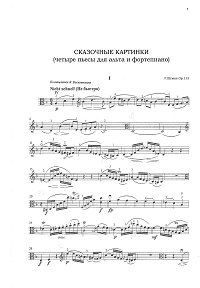Schumann - Fairytales for viola op.113 (Märchenbilder)
Schumann - Fairytales for viola. You can download the sheet music Schumann - Fairytales for viola on this page. Ludewig viola part edition. The genre character of Märchenbilder for piano and viola, op. 113, written in 1851, is more pronounced. Although the work only consists of "images" rather than concrete stories, each piece has a marked semantic vein that evokes specific associations. Thus the two flanking movements evoke the character of a subdued, melancholy round dance, the "galloping" rhythm of the second movement turns it into a kind of riding piece, while the unrest and the drama of the third movement recall an ancient epic. Schumann delicately sketches the dark coloring of the viola between expressive cantilenas and accompanying arpeggios, and on hearing the gentle pizzicato with which the first Märchenbild draws to a close, one is reminded of the first of Gyorgy Kurtag's pieces for solo viola.
To download PDF, click the "Download PDF" button below the appropriate sheet music image.
To view the first page of Schumann - Fairytales for viola click the music sheet image.
|
| PDF format sheet music |
|
|
|
Viola part: 10 pages. 2067 K
|
Piano part: 28 pages. 5842 K
|
 |
 |
| +++ |
+++ |
| Download PDF (14.99
€) |
Download PDF (14.99
€) |
|
Following the composition of the Fantasiestucke for piano and clarinet, op. 73, in 1849, Robert Schumann became especially interested in the chamber music miniature, which he scored for instrumental ensembles uncommon in the conventional genres such as the string quartet. The three Fantasiestucke, op. 73, are snort character images of expression that lie, semantically speaking, between an "absolute" concept of the sonata and a series of genre pieces with concrete, programmatic imagery. The three movements are not composed as parts of a classically romantic "sonata", and are instead related to three-part song or rondo form, but the interweaving of motifs between the movements does indicate an overlapping, more "abstract" musical approach. The genre character that is more pronounced in the following works, but tangible here as well, is balanced by the song like melody of the clarinet voice that repeatedly refers to Schumann's earlier songs: the second fantasy piece quotes from the song Mit Myrten und Rosen (op. 24, no. 9, after Heinrich Heine), and in the middle section of the third piece Schumann quotes Erstes Grün (op. 35, no. 4), his musical setting of a poem by Justinus Kerner. The mood was not inspired so much by the content of the poems - Heine's brand of irony was hardly to Schumann's taste — as by the "tone", the melodic coloring, in conjunction with typically Schumannesque harmonics. The result is a cycle that shows a distinctive range of expression despite its "simplicity".
|
|